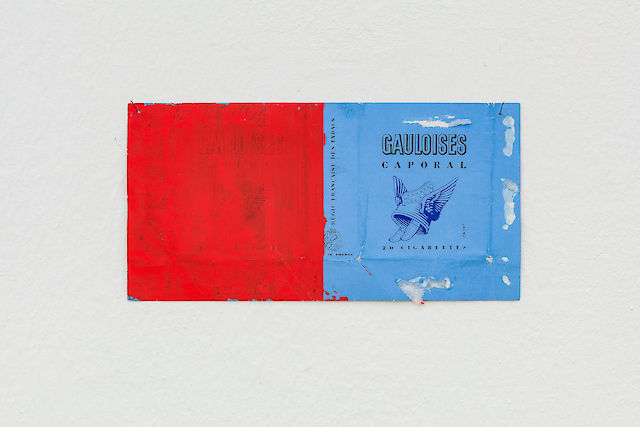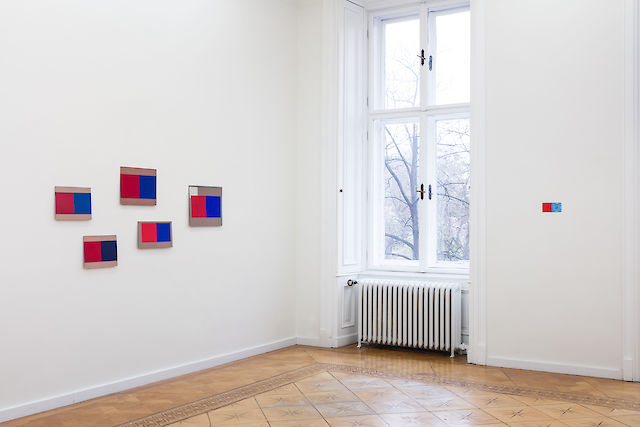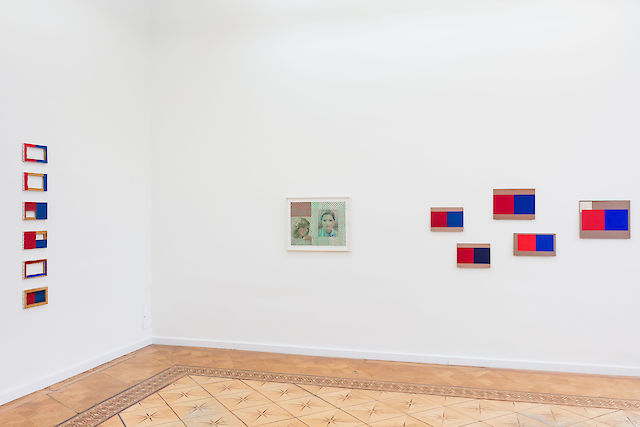Images
Albert Mertz
18. 3. – 16. 5. 2020

Albert Mertz, installation view, Croy Nielsen, Vienna, 2020

Albert Mertz, Gauloises papers, 1976, Gouache on paper, 9 × 17.5 cm

Albert Mertz, installation view, Croy Nielsen, Vienna, 2020

Albert Mertz, installation view, Croy Nielsen, Vienna, 2020

Albert Mertz, Grønne damer røde prikker (Green Ladies, Red dots), 1979, Collage, 51 × 65 cm

Albert Mertz, installation view, Croy Nielsen, Vienna, 2020

Albert Mertz, Untitled (R/B on board), 1970ies, Acrylic on cardboard (backside of a drawing block, incl. metal spiral and stickers), 38.5 × 46 cm

Albert Mertz, installation view, Croy Nielsen, Vienna, 2020

Albert Mertz, installation view, Croy Nielsen, Vienna, 2020

Albert Mertz, Untitled, 1974, Oil on canvas, 6 canvases, each: 16 × 27 × 2 cm

Albert Mertz, Untitled (detail), 1974, Oil on canvas, 6 canvases, each: 16 × 27 × 2 cm

Albert Mertz, installation view, Croy Nielsen, Vienna, 2020

Albert Mertz, installation view, Croy Nielsen, Vienna, 2020

Albert Mertz, Untitled, 1987, Gouache on paper, 29.7 × 42 cm, framed:: 36.2 × 48.5 cm

Albert Mertz, Untitled, 1987, Gouache on paper, 29.7 × 42 cm, framed:: 36.2 × 48.5 cm

Albert Mertz, installation view, Croy Nielsen, Vienna, 2020

Albert Mertz, Two heads, 1984, gouache, framed, 29.7 × 42 cm, framed: 53 × 62 × 3 cm

Albert Mertz, Untitled (r/b on white), 1982, Acrylic on Masonite, 49 × 70 cm

Albert Mertz, installation view, Croy Nielsen, Vienna, 2020

Albert Mertz, Untitled (four houses, falling), 1984, gouache on paper, framed, 75 × 30 cm, framed: 97 × 35 × 3 cm

Albert Mertz, Untitled (long profile), 1984, gouache on paper, framed, 75 × 30 cm, framed: 97 × 35 × 3 cm

Albert Mertz, Untitled (windows), 1984, gouache on paper, framed, 75 × 30 cm, framed: 97 × 35 × 3 cm

Albert Mertz, Untitled (two houses), 1984, gouache on paper, framed, 75 × 30 cm, framed: 97 × 35 × 3 cm
Photos by Kunst-dokumentation.com
Press Release
We are pleased to present a selection of works by Albert Mertz (1920 – 1990) on the occasion of his 100th birthday.
Part of the exhibition features works created during the time Mertz resided in Savigny-sur-Orge, a Parisian suburb, from the early 1960ies until 1976. The walls of his flat were brown from the smoke of innumerable Gauloises, and when Lone Mertz first visited in 1975, she was overwhelmed by the largest wall of the living room, filled from floor to ceiling with an enormous collage:
There sat Marcel Duchamp, side by side with Mondrian and Andy Warhol, Brigitte Bardot and Marilyn Monroe, Mickey Mouse and Donald Duck, all the heroes and heroines separated by glossy paper, gold and strident daubs of Allak (poster paint).
The wall changed constantly; whenever a new and attractive picture turned up in “Life“ or “Elle“ or “Nouvel Observateur“, or in any of the other periodicals that landed in a steady stream on the reading piles, Albert would find the glue pot and slap on the glue with a graceful gesture – and, hey presto! – the new picture was on the wall.
I grew to love that flat. The first large red-blue rectangles were painted in situ above the service hatch to the kitchen and around them hung the first attempts in red and blue, executed on large pieces of brown hardboard in different types of paint. Points of stillness placed in the world: above the television, besides the old-fashioned telephone with its old-fashioned dial, high and low, and then they were even reversible.1
The five works from the series r/b on board (1970ies) stem from this period and are all painted on the back board of used drawing blocks. Some of them are reversible. Mertz would use whatever came at hand as the basis of his compositions: even his Gauloises cigarette wrappers were painted red and blue. When using more traditional image carriers, these would often become the very subject of Mertz’ structural investigations: Untitled (1974) features six small canvases in red and blue, partially or completely deconstructed: here a corner is missing, there the whole surface (canvas) has been cut-out and the paint transferred directly to the strecher bars.
The exhibition also includes one of the print sheets for Mertz’ La Maison Rouge + Bleu: a book printed at Atelier Clot in Paris in 1973. The house remained one of Mertz’ favourite motives and can also be found in several works from the 1980ies such as Untitled (four houses falling) or Untitled (windows) (both 1984).
Albert Mertz (1920 – 1990) had his exhibition debut only thirteen years old in 1933 and started at the Royal Danish Academy of Fine Arts in 1936. Several years later he became a teaching professor at the same institution from 1979 until his death in 1990. Mertz is recognized for his art critics, his experimental films and in his work as a painter. He was co-founder of the Linien II in 1947, and represented Denmark posthumously at the 21st Sao Paulo Biennale, Brazil in 1991. Albert Mertz is represented in all major Danish art museums, in Moderna Museet, Stockholm, Sweden, The National Gallery, Oslo Norway and in major collections such as Daimler Art Collection in Berlin.
A special thanks to Lone Mertz for making this exhibition possible.
1. Lone Mertz, ‘Albert’, in Albert Mertz, Nikolai Copnehagen Contemporary Art Center, 1999